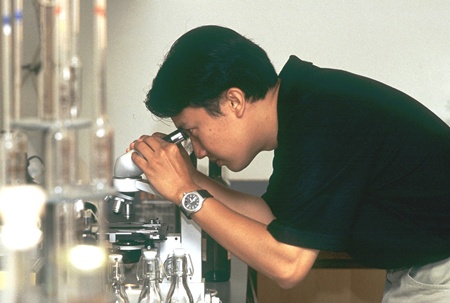The story is well-known, but in case you are new to these parts, I’ll tell it again. It won’t take long, so sit up and listen, especially those boys slouching at the back. Traditionally, grapes for wine-making have been grown between the 30th and 50th parallels in both the northern and southern hemispheres.
Thailand has pioneered wine production in a narrow band between the 14th and 18th parallels. Years of research, testing and development have opened up new frontiers in Thai wine-making resulting in the so-called “New Latitude Wines”.
 Quality control with Prayut Piangbunta of Khao Yai Winery.
Quality control with Prayut Piangbunta of Khao Yai Winery.
Not long ago it was thought impossible, but now a handful of wineries are turning out award-winning wines made from grapes grown at the exotic tropical latitude of 14.3 degrees north of the Equator. One of these is the Khao Yai Winery, which produces a range of interesting wines, including the delightful ‘Sawasdee” wines that I told you about a few weeks ago.
Pirom PB Valley Khao Yai Reserve Chenin Blanc 2010 (white), Thailand (Various outlets, Bt. 1,250)
The Chenin Blanc grape (Shen-ihn BLAHN) hails from the Loire Valley in France. This wine was made from grapes grown here in Thailand, not far from Khao Yai National Park. The winery makes three Chenin Blancs and this one is the top of the range. It is the most delicate colour; the lightest gold that you can imagine. There’s a kaleidoscope of floral aromas: passion fruit, pears, gooseberries, ripe bananas, dried herbs and a dash of spice. You might also pick up a faint hint of pear drops.
It’s a youthful and fairly light-bodied dry wine, but it’s loaded with exotic fruit and citrus tastes, framed in a perfect balance of acidity. There’s a lovely fruity, slightly peppery finish too. The wine has an alluring mouth-feel and must be Khao Yai’s best Chenin Blanc vintage yet. It was made by Prayut Piangbunta, Thailand’s first native-born winemaker who is also the Chief Winemaker and Director of Khao Yai. The more I taste Khao Yai wines, the more I am convinced that through their aroma and taste, Prayut has captured something essentially Thai.
If you love dry, fruity whites then do give it a try. The makers suggest that you could serve it with seafood but even at 13.5% alcohol, the wine is so good that I’d want to drink it on its own, perhaps as an apéritif before dinner. Oh, and in case you’re wondering, the letters “PB” are the initials of company’s founder, Dr. Piya Bhirombhakdi and the word “Pirom” is derived from the first part of his surname.
Pirom PB Valley Khao Yai Reserve Tempranillo 2010 (red), Thailand (Various outlets, Bt. 1,250)
Now then, here’s a quiz question for you. Which country is traditionally associated with the Tempranillo grape? If you know already, good for you. Collect the prize money at the door on your way out.
If you are still bewildered, the answer is Spain. Tempranillo (tem-prah-NEE-yoh) is Spain’s best-loved and most prized grape variety. It’s the source of one of their most famous wines – the fruity red, earthy and often delicate wine known after its place of origin, Rioja.
The grape variety seems to thrive at this latitude in Khao Yai’s cool, high vineyards. The wine is ruby-red, full-bodied and dry as they come, with blackberries and black cherries up front. It has a distinctly spicy character, a very smooth mouth-feel, a firm foundation of tannin and a long, dry oaky finish. The wine has a hefty 13.5% of alcohol and it’s very much a food wine. The makers recommend pairing it with duck, game or most red meat dishes.
In many ways, this wine is exceptional, because the weather was just about ideal and high quality grapes were produced. If you enjoy dry, hearty reds, you should give this a try.
You may need to do a bit of searching for these Pirom wines for they seem to sell quickly. However, the makers tell me that you can often find them at Makro, Villa, Big C and Foodland as well as Eataly (Jomtien) and Aroy Italy (Sukhumvit). They are certainly worth seeking out.




